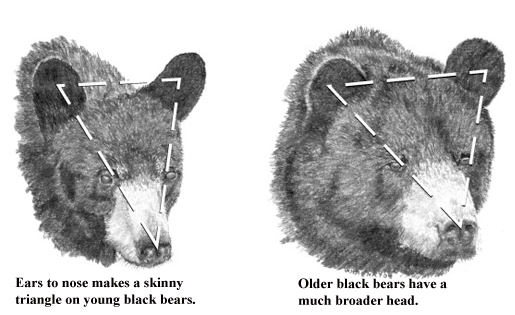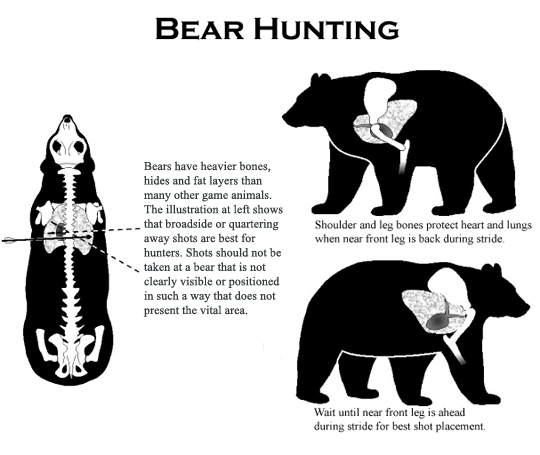Bear Hunting Techniques
Hunting bears requires that the hunter overcome several
disadvantages in the pursuit of his quarry. While hunting in
Maryland, the bear hunter will be pursuing an animal that roams a
large territory and is intimate with the terrain and habitat.
Additionally, the hunter will be challenged to overcome the bears’
superior senses, in particular, their keen sense of smell.
A bear’s snout is packed with nasal sinuses that can detect
scents on a molecular level. They use their nose to detect danger,
to socially interact with other bears, and to find food. The hunter
should always keep scent control in mind while scouting and hunting.
Bears will check the wind before making an approach to a feeding
area so the hunter will want to study prevailing winds and position
himself down-wind from the bear’s most likely approach. Choice of
clothing is imperative too. Wear rubber footwear and clothes free of
camp or home odors to reduce the chance of a bear detecting your
presence. The use of scent- adsorptive clothing products and cover
scents to mask your presence are recommended. Keep in mind, however,
that scent attractants (scents placed to draw an animal close) are
not legal for use in Maryland.
Stand Hunting
Likely, the most popular and productive way to hunt bears is from
a stand. The hunter chooses an area where he expects to see a bear
and then waits patiently for its arrival. A hunter in a stand,
remaining still and quiet, blends in with his surroundings and
creates a perfect setting for a wildlife encounter. Hunting from an
elevated point, such as a tree stand, will increase a hunter’s
visibility and will help to keep his scent and any movement above a
bear’s normal plane of detection. Having an intimate knowledge of
your hunting area, gained through pre-season scouting, will help you
to place your stand in the best possible location. When choosing a
stand location, you may want to focus on feeding areas, bedding
areas, or travel routes. When setting a stand up along travel
routes, consider placing your stand 15 yards or more off of the
trail to minimize the chance of a bear detecting you.
Tree Stand Safety
Because of all the advantages they offer, tree stands are one of the most popular pieces of big game hunting equipment. However, a tree stand can be dangerous if used carelessly or incorrectly. In Maryland, the leading cause of hunting accidents is tree stand related. Falling from tree stands is a common accident and can be caused by a variety of reasons including failure of the stand and incorrect installation. Hunters are urged to exercise caution when using tree stands, become familiar with their operation, and carefully inspect all tree stands before using them. The Maryland DNR recommends that all hunters hunting from an elevated stand use a Tree stand Manufacturer’s Association-approved full-body safety harness. Additionally, DNR strongly recommends using a sliding knot, commonly known as a prussic knot, attached to a line that is secured above the stand that allows the hunter to be safely tethered to the tree as soon as they leave the ground. Visit the DNR Website to see more information on tree stand safety and view a helpful video at http://dnr.maryland.gov/nrp/Pages/treestand_tips.aspx
Still-Hunting
Still-hunting, or sneaking through the woods, can be an effective way to hunt bears. While still-hunting, hunters should move slowly and stop periodically to scan the surroundings for signs of bears. Hunters may want to still-hunt where they can observe a large area, such as a ridge overlooking a potential feeding or bedding site (such as an oak flat, stream drainage, or rhododendron thicket). While still-hunting, be certain to pay attention to wind direction so that a bear doesn’t detect your presence. In western states with open country, hunters will often glass an area with binoculars until a bear is located. Then they formulate a downwind approach placing them in range for an effective shot. Glassing mountain hollows or agricultural areas may prove to be an effective technique for the still-hunter in Maryland.
Driving
Like white-tailed deer, bears may be “pushed” through an area by
drivers toward standers positioned for a shot. Remember, in
Maryland, any person participating in a bear hunt, including drivers,
must possess a bear-hunting permit. Likely areas to drive in search
of a bear may include agricultural areas, young clear-cuts with
dense vegetation, rhododendron thickets, and wet areas such as bogs
or stream bottoms.
Calling
As is true with foxes and coyotes, bears may sometimes be lured in by the sound of a predator call. Fawn bleats, injured-rabbit sounds, and even turkey calls have been used successfully to draw bears. Choose an area that is frequented by bears, like a feeding or bedding site. Some literature suggests that bears have a short attention span and that persistent calling works best. It is advisable to call with a partner as he can help you maintain continuous calling and can act as a guard for your backside. Choose a calling area with a good field of view at your front and on both sides where the least likely approach by a bear is from behind. A bear’s approach to a calling site can vary from nonchalance to an aggressive charge.
Choosing Your Bear
Maryland hunters are not restricted to certain sizes or age
classes of bears. Each hunter will have to decide which is the right
animal and when is a good time to shoot. The chance to legally take
a bruin in Maryland is a tremendous opportunity. Many areas may hold
several bears and some hunters may choose to pass up smaller bears
for a large, mature animal. Because of their dark coloration and
dense, rounded frame, it can be difficult to determine the age and
size of a bear in the woods. Typically though, a large bear will
appear to have small ears in relation to its large, rounded head.
Also bigger bears will have stocky legs and a belly closer to the
ground. They will move slowly and deliberately with confidence.
Smaller bears, on the other hand, have ears that appear large and
sit close together high on their narrow head. Their legs appear long
and bandy and their behavior may seem quick and nervous. Hunters may
encounter bears that are ear-tagged or radio-collared. These animals
are not restricted from the hunt and are considered legal game.
Radio collars from harvested bears must be forfeited to the Maryland
Wildlife & Heritage Service at the check-in station.

Shot Placement
As is true with all hunting situations, when it comes time to
make the shot, it is imperative that the hunter makes every attempt
to place a shot that will be quick and effective. In order to make a
quick kill, the hunter must be proficient with his firearm or bow,
understand their personal effective range, and have an understanding
of basic bear anatomy. Hunters must understand that bears are built
differently than deer and other big game animals. The chest of a
bear is compressed compared to that of a deer when looking at it
from the side. A hunter who shoots ahead of the front shoulder may
miss the animal, or worse, injure the animal with little chance of
recovery. While either a broadside or quartering away shot is an
excellent shot opportunity for a firearm hunter, an archers’ best
shot opportunity is a broadside shot. The broadside shot requires
less penetration for the arrow to reach the vital organs. Wait for
the bear to step forward with the near side leg exposing the
heart/lung area. A bear’s most vital area is an 8” circle behind the
front shoulder. Since bears have massive, muscular shoulders and
heavy bones, a shoulder shot is not recommended. Head shots are not
recommended either since a bear skull is very dense and its blunt,
rounded shape can cause bullets or arrows to glance off
ineffectively. When hit, a bear will generally run, perhaps for
miles, before dying if a good shot is not made. Additionally, bears
have heavier bones, hides, and fat layers than many other game
animals. All of these features may inhibit blood dripping to form a
good blood trail, making an injured bear difficult to track.
Therefore, proper shot placement is essential. Shots should not be
taken at a bear that is not clearly visible or positioned in such a
way that does not present the vital area.
